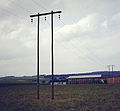Mast picture
The mast pattern of an overhead line is the appearance that results from the arrangement of the conductor cables on the overhead line masts .
In addition to the electrical behavior, the choice of the mast pattern primarily affects the structural height and width requirements of the route. One-level arrangements (all ladders next to each other at the same height) require little height but a lot of width, which is particularly disadvantageous when the route leads through forest areas and wide aisles have to be cut. Three-level arrangements require less width but more height, which can make it difficult to cross lines and increase the wind load on the masts. Two-level arrangements such as the Danube mast represent a compromise.
In windy areas, stability aspects also play a role: delta masts are structurally elastic, they can "yield" and thus absorb high lateral forces.
Examples
A traverse
Two trusses
Three trusses
Combinations
commitment
The single-level mast is common for HVDC overhead lines with only two conductor cables.
Railway power lines with up to two circuits also mostly use the one-level arrangement; in the case of four circuits, two levels are used. Railway power lines with six circuits are laid on three levels on the mast, so that the mast carries four conductor cables on each of its three trusses.
Three-phase lines with up to two circuits mostly use the Danube mast arrangement in Germany. Three-level masts are used for four circuits at the same voltage level. Four three-phase circuits with different voltages are accommodated on the masts as standard in such a way that two circuits for the lower voltage hang on the lowest crossbeam and the circuits for the higher voltage hang on the top two - in a Danube arrangement. For high-voltage lines with two circuits, the one- level arrangement , the barrel mast , the Christmas tree mast and especially the Danube mast are the usual masts.
For a three-phase circuit, the single-level arrangement (also used abroad on delta masts and portal masts ) or mast designs with three offset cross members are used.
Hybrid masts for the accommodation of traction current and three-phase circuits usually have three traverses, whereby the two traction current circuits are accommodated on the lowest traverse, while two three-phase circuits are arranged on the top two traverses like a Danube mast.
Individual evidence
- ↑ Girkmann K., Königshofer E .: The components of the high-voltage overhead line , the mast picture and the electrical characteristics . In: The high-voltage overhead lines. Springer, Vienna . 1952. doi : 10.1007 / 978-3-7091-3113-8_2 .









